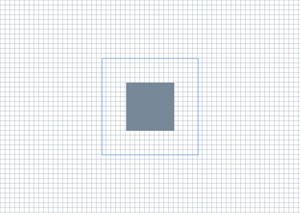ID2D1RenderTarget::DrawRectangle(constD2D1_RECT_F&,ID2D1Brush*,FLOAT,ID2D1StrokeStyle*) method (d2d1.h)
Draws the outline of a rectangle that has the specified dimensions and stroke style.
Syntax
void DrawRectangle(
const D2D1_RECT_F & rect,
ID2D1Brush *brush,
FLOAT strokeWidth,
ID2D1StrokeStyle *strokeStyle
);
Parameters
rect
Type: [in] const D2D1_RECT_F &
The dimensions of the rectangle to draw, in device-independent pixels.
brush
Type: [in] ID2D1Brush*
The brush used to paint the rectangle's stroke.
strokeWidth
Type: [in] FLOAT
The width of the stroke, in device-independent pixels. The value must be greater than or equal to 0.0f. If this parameter isn't specified, it defaults to 1.0f. The stroke is centered on the line.
strokeStyle
Type: [in, optional] ID2D1StrokeStyle*
The style of stroke to paint, or NULL to paint a solid stroke.
Return value
None
Remarks
When this method fails, it does not return an error code. To determine whether a drawing method (such as DrawRectangle) failed, check the result returned by the ID2D1RenderTarget::EndDraw or ID2D1RenderTarget::Flush method.
Examples
The following example uses an ID2D1HwndRenderTarget to draw and fill several rectangles. This example produces the output shown in the following illustration.

// This method discards device-specific
// resources if the Direct3D device disappears during execution and
// recreates the resources the next time it's invoked.
HRESULT DemoApp::OnRender()
{
HRESULT hr = S_OK;
hr = CreateDeviceResources();
if (SUCCEEDED(hr))
{
m_pRenderTarget->BeginDraw();
m_pRenderTarget->SetTransform(D2D1::Matrix3x2F::Identity());
m_pRenderTarget->Clear(D2D1::ColorF(D2D1::ColorF::White));
D2D1_SIZE_F rtSize = m_pRenderTarget->GetSize();
// Draw a grid background.
int width = static_cast<int>(rtSize.width);
int height = static_cast<int>(rtSize.height);
for (int x = 0; x < width; x += 10)
{
m_pRenderTarget->DrawLine(
D2D1::Point2F(static_cast<FLOAT>(x), 0.0f),
D2D1::Point2F(static_cast<FLOAT>(x), rtSize.height),
m_pLightSlateGrayBrush,
0.5f
);
}
for (int y = 0; y < height; y += 10)
{
m_pRenderTarget->DrawLine(
D2D1::Point2F(0.0f, static_cast<FLOAT>(y)),
D2D1::Point2F(rtSize.width, static_cast<FLOAT>(y)),
m_pLightSlateGrayBrush,
0.5f
);
}
// Draw two rectangles.
D2D1_RECT_F rectangle1 = D2D1::RectF(
rtSize.width/2 - 50.0f,
rtSize.height/2 - 50.0f,
rtSize.width/2 + 50.0f,
rtSize.height/2 + 50.0f
);
D2D1_RECT_F rectangle2 = D2D1::RectF(
rtSize.width/2 - 100.0f,
rtSize.height/2 - 100.0f,
rtSize.width/2 + 100.0f,
rtSize.height/2 + 100.0f
);
// Draw a filled rectangle.
m_pRenderTarget->FillRectangle(&rectangle1, m_pLightSlateGrayBrush);
// Draw the outline of a rectangle.
m_pRenderTarget->DrawRectangle(&rectangle2, m_pCornflowerBlueBrush);
hr = m_pRenderTarget->EndDraw();
}
if (hr == D2DERR_RECREATE_TARGET)
{
hr = S_OK;
DiscardDeviceResources();
}
return hr;
}
For a related tutorial, see Create a simple Direct2D application.
Requirements
| Requirement | Value |
|---|---|
| Minimum supported client | Windows 7, Windows Vista with SP2 and Platform Update for Windows Vista [desktop apps | UWP apps] |
| Minimum supported server | Windows Server 2008 R2, Windows Server 2008 with SP2 and Platform Update for Windows Server 2008 [desktop apps | UWP apps] |
| Target Platform | Windows |
| Header | d2d1.h |
| Library | D2d1.lib |
| DLL | D2d1.dll |
See also
Create a simple Direct2D application
Feedback
Coming soon: Throughout 2024 we will be phasing out GitHub Issues as the feedback mechanism for content and replacing it with a new feedback system. For more information see: https://aka.ms/ContentUserFeedback.
Submit and view feedback for